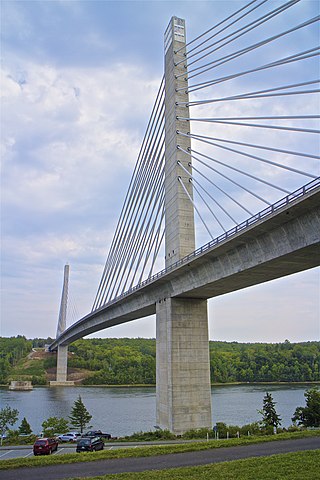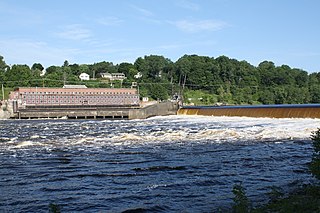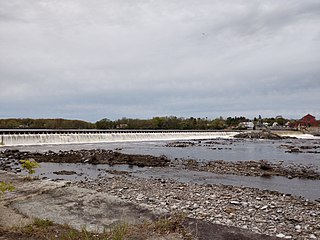
Bangor is a city in and the county seat of Penobscot County, Maine, United States. The city proper has a population of 31,753, making it the state's third-largest settlement, behind Portland (68,408) and Lewiston (37,121). Bangor is known as the “Queen City.”

Brewer is a city in Penobscot County, Maine, United States. It is part of the Bangor, Maine Metropolitan Statistical Area. The city is named after its first settler, Colonel John Brewer. The population was 9,672 at the 2020 census.

Old Town is a city in Penobscot County, Maine, United States. The population was 7,431 at the 2020 census. The city's developed area is chiefly located on the relatively large Marsh Island, but its boundaries extend beyond it. The island is surrounded and defined by the Penobscot River to the east and the Stillwater River to the west.

Penobscot Indian Island Reservation is an Indian reservation for the Penobscot Tribe of Maine, a federally recognized tribe of the Penobscot in Penobscot County, Maine, United States, near Old Town. The population was 758 at the 2020 census. The reservation extends for many miles alongside 15 towns and two unorganized territories in a thin string along the Penobscot River, from its base at Indian Island, near Old Town and Milford, northward to the vicinity of East Millinocket, almost entirely in Penobscot County. A small, uninhabited part of the reservation used as a game preserve and hunting and gathering ground is in South Aroostook, Aroostook County, by which it passes along its way northward.

Millinocket is a town in Penobscot County, Maine, United States. The population was 4,114 at the 2020 census.
The Penobscot are an Indigenous people in North America from the Northeastern Woodlands region. They are organized as a federally recognized tribe in Maine and as a First Nations band government in the Atlantic provinces and Quebec.

The Penobscot River is a 109-mile-long (175 km) river in the U.S. state of Maine. Including the river's West Branch and South Branch increases the Penobscot's length to 264 miles (425 km), making it the second-longest river system in Maine and the longest entirely in the state. Its drainage basin contains 8,610 square miles (22,300 km2).

The Waldo–Hancock Bridge was the first long-span suspension bridge erected in Maine, as well as the first permanent bridge across the Penobscot River downstream from Bangor. The name comes from connecting Waldo and Hancock counties. The bridge was built in 1931 and retired in 2006, when the new Penobscot Narrows Bridge was opened just a few yards away, and it was demolished in 2013.

The North Maine Woods is the northern geographic area of the state of Maine in the United States. The thinly populated region is overseen by a combination of private individual and private industrial owners and state government agencies, and is divided into 155 unincorporated townships within the NMW management area. There are no towns or paved roads.

The Penobscot Narrows Bridge is a 2,120-foot-long (650 m) cable-stayed bridge that carries US 1/SR 3 over the Penobscot River. It connects Verona Island to Prospect, in the U.S. state of Maine. It opened in December 2006, replacing the Waldo–Hancock Bridge, built in 1931.

The West Branch Penobscot River is a 117-mile-long (188 km) tributary of the Penobscot River through the North Maine Woods in Maine. The river is also known as Abocadneticook, Kahgognamock, and Kettegwewick.

The Great Works Dam was a dam on the Penobscot River between Old Town and Bradley in Penobscot County, Maine, USA. The original Great Works Dam was constructed in the 1830s and replaced between 1887 and 1900. The dam was originally owned by the Penobscot Chemical Fibre Company and was acquired by Diamond International Corporation in 1968 along with the adjacent mill. The dam and powerhouse were sold several more times, and in 2010 the Penobscot River Restoration Trust bought the dam from PPL Corporation based on an agreement that was signed in 2004. On June 11, 2012, deconstruction of the dam began as a part of an extensive project involving four dams to restore eleven species of sea-run fish to the Penobscot River.

The Veazie Dam was a hydroelectric dam on the Penobscot River between Veazie and Eddington in Penobscot County, Maine. In 2010 the Penobscot River Restoration Trust bought the dam from PPL Corporation based on an agreement that was signed in 2004. Deconstruction of the dam began on July 22, 2013 as a part of an extensive project involving four dams to restore eleven species of sea-run fish to the Penobscot River. The Veazie Dam was the furthest downstream of the dams on the Penobscot River; now the Milford and Orono Dam dams are furthest downstream, albeit on separate side of Marsh Island. The Great Works Dam, which was 8 mi (13 km) upstream of the Veazie Dam, was removed in 2012.

The Milford Dam is a dam on the Penobscot River between Old Town and Milford in Penobscot County, Maine. The dam will receive a new fish lift as a part of an extensive project involving four dams to restore eleven species of sea-run fish to the Penobscot River. The Great Works Dam was removed in 2012 and was just downstream of the Milford Dam. The dam's power plant has an 8 MW installed capacity.
The Stillwater Dam is a hydroelectric dam on the Stillwater River in Old Town north of downtown Orono in Penobscot County, Maine. As a part of the Penobscot River restoration and the removal of the Great Works and Veazie dams, the Stillwater Dam and the Orono Dam will be upgraded to maintain previous levels of power generation.
The Orono Dam is a hydroelectric dam on the Stillwater River at its confluence with the Penobscot River in Orono, Penobscot County, Maine. As a part of the Penobscot River restoration and the removal of the Great Works and Veazie dams, the Orono Dam and Stillwater Dam will be upgraded to maintain previous levels of power generation.
The West Enfield Dam, also known as the Stanford Dam, is a hydroelectric dam on the Penobscot River just above its confluence with the Piscataquis River between the towns of Enfield and Howland in Penobscot County, Maine, USA.The dam actually traverses a thin strip of the territory of the Penobscot Indian Island Reservation. The dam has a fish passage. Its power plant has an 13 MW installed capacity.

Great Northern Paper Company was a Maine-based pulp and paper manufacturer that at its peak in the 1970s and 1980s operated mills in Arkansas, Georgia, Maine, and Wisconsin and produced 16.4% of the newsprint made in the United States. It was also one of the largest landowners in the state of Maine.

Hollywood Casino Hotel & Raceway Bangor is a casino and harness racing track in Bangor, Maine. It is owned by Gaming and Leisure Properties and operated by Penn Entertainment. It was the first licensed slots facility in the state, and became the first casino to be licensed in the state of Maine when it added table games to its facilities in 2012. The only other licensed casino in the state is Oxford Casino in Oxford, Maine. As of 2021, the casino had 12 tables and 723 slot machines. The hotel has 152 rooms, including four suites.

The Natural Resources Council of Maine (NRCM) is a Maine-based, 501(c)(3) non-profit organization, with offices in Augusta, Maine. Founded in 1959 as a small, volunteer-based environmental advocacy group, NRCM has grown to be Maine's largest environmental advocacy organization, with more than 25,000 supporters and activists and a staff of 28, including science and policy experts.

















